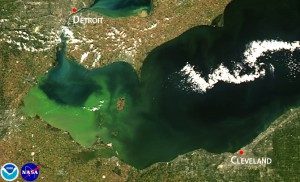When Pennsylvania Governor Tom Corbett learned of the large toxic cyanobacteria (blue-green algae) bloom that disrupted the drinking water supply for hundreds of thousands of Ohio’s citizens, he expressed confidence his state was proactively planning to mitigate any potential human health impacts from toxic cyanobacteria blooms. This confidence grew from the state Department of Environmental Protection (PADEP) leading a Pennsylvania Lake Erie Harmful Algal Bloom (HAB) Task Force and Monitoring and Response Strategy piloted in the summer of 2014. Both stemmed from a 2013 NCCOS HAB Event Response (HAB ER) project. The strategy lists NOAA as a possible partner contributing research on environmental conditions that promote HAB development for predictive purposes and support to address HAB science priorities.

The NCCOS HAB ER program remainsengaged with the Task Force, andin late October, the group completed planning for the upcoming bloom season by identifying and coordinating resources needed to respond to any cyanobacteria HAB events. The need forbetter forecasting, monitoring, and impactcontrol and prevention oftoxic HAB events were identified as science priorities. The strategiesin development arepart of a commonwealth-wide program for HAB monitoring, response and prevention – a model the state may ultimately adopt to help meet anticipated requirements to assess water quality under the Clean Water Act.
Task Force members include representatives from the three primary state agencies with authority to carry out the strategy: PADEP, Department of Conservation and Natural Resources (PADCNR ), and the Erie County Department of Health, with support from local scientists, water resource managers and the public.
For more information, contact Marc.Suddleson@noaa.gov.
